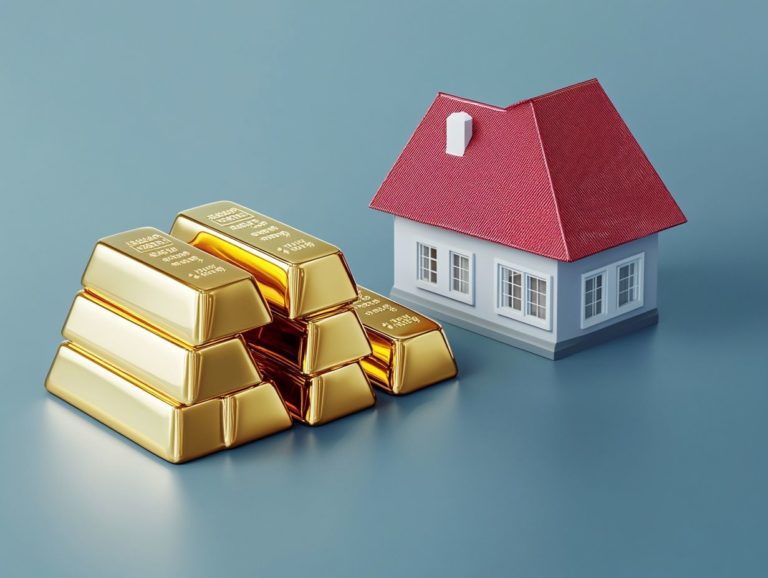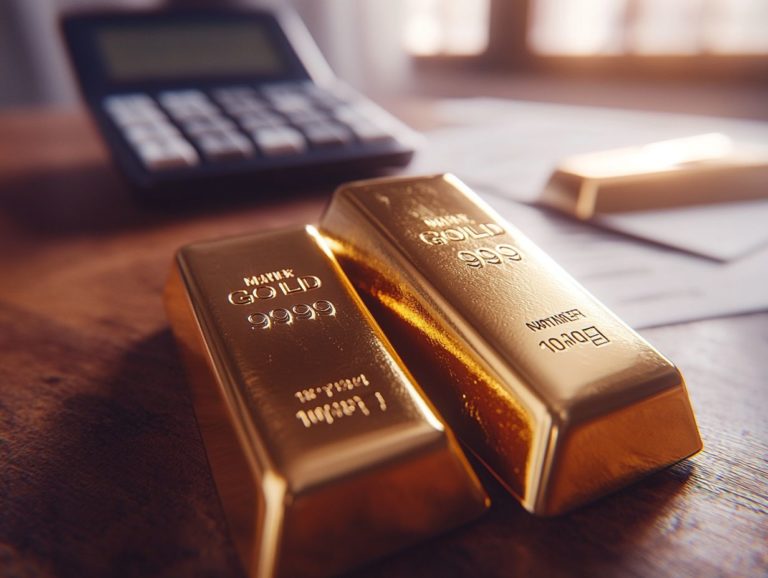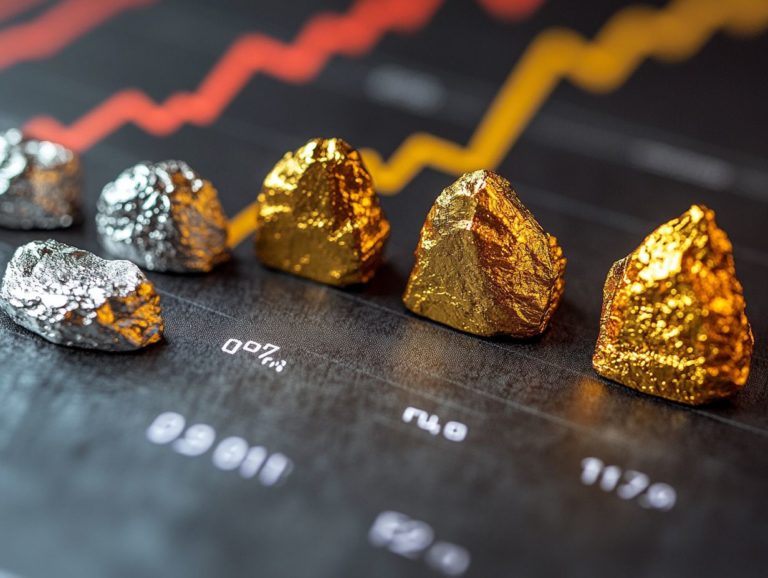The Role of Precious Metals in Tax-Advantaged Accounts
Tax-advantaged accounts offer a great opportunity to grow your wealth while benefiting from potential tax advantages. By incorporating precious metals like gold and silver into these accounts, you can enhance your investment strategy.
This article explores the essentials of tax-advantaged accounts, highlights the benefits of investing in precious metals, and outlines which types are suitable for these accounts. It also guides you through the investment process, addressing important rules and potential risks along the way.
Discover a pathway to secure your financial future.
Contents
- Key Takeaways:
- The Basics of Tax-Advantaged Accounts
- The Benefits of Investing in Precious Metals
- Types of Precious Metals Suitable for Tax-Advantaged Accounts
- How to Invest in Precious Metals through Tax-Advantaged Accounts
- Considerations and Risks
- Frequently Asked Questions
- What are tax-advantaged accounts?
- What are precious metals?
- Why should I consider investing in precious metals within a tax-advantaged account?
- What are the different types of tax-advantaged accounts that allow investment in precious metals?
- Are there restrictions on the types of precious metals that can be held in a tax-advantaged account?
- What are the potential risks and benefits of investing in precious metals within a tax-advantaged account?
Key Takeaways:
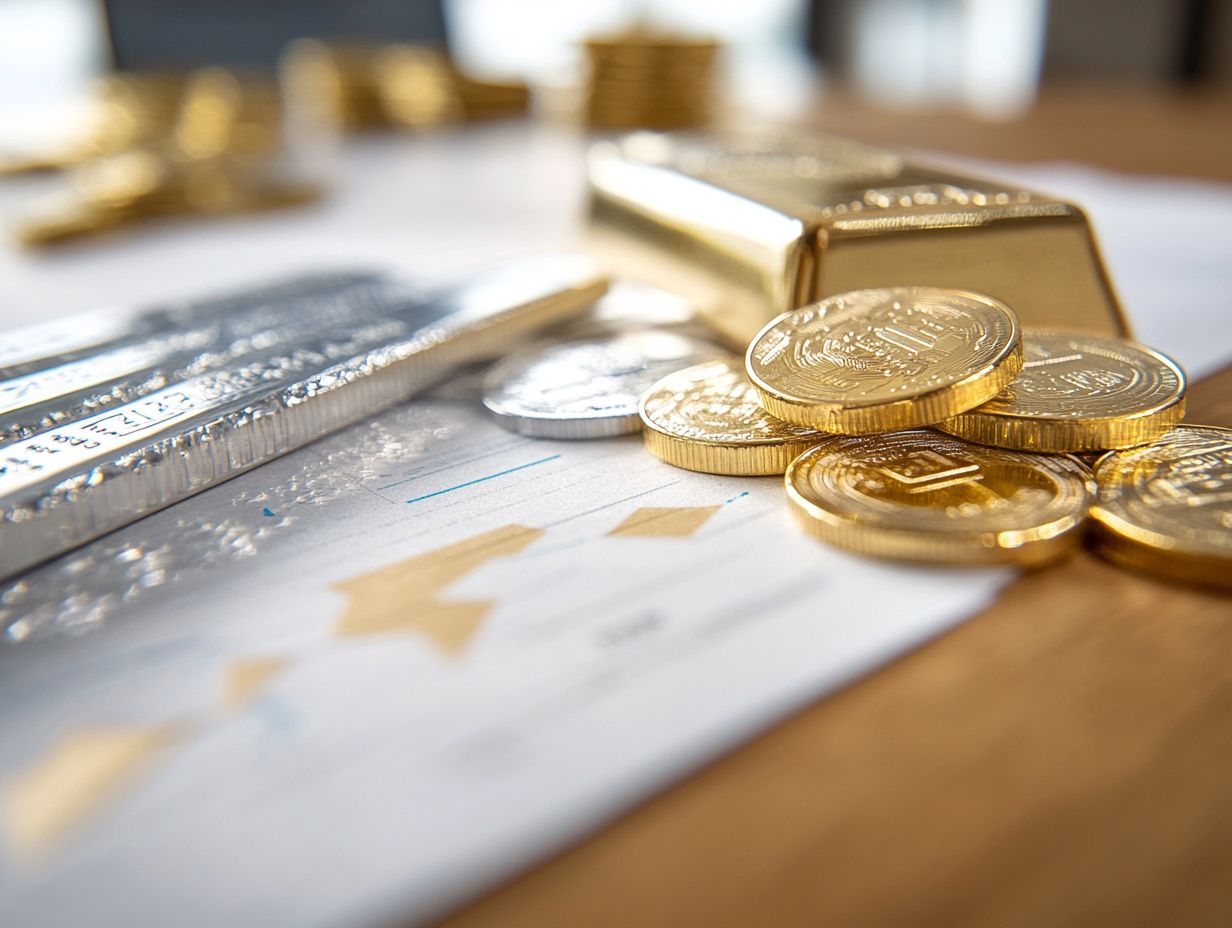
- Diversifying your tax-advantaged accounts with precious metals can help protect against inflation and market volatility.
- Gold, silver, platinum, and palladium are all suitable options for tax-advantaged accounts and offer tax benefits.
- Understanding the rules of investing in precious metals through tax-advantaged accounts is crucial to avoid potential risks.
The Basics of Tax-Advantaged Accounts
Tax-advantaged accounts are powerful financial tools designed to help you save for retirement by providing distinct tax benefits. These benefits include tax-deferred growth and tax-free withdrawals, making them an excellent choice for long-term investment.
Consider IRAs and 401(k)s, which allow you to invest across various types of assets while ensuring compliance with IRS guidelines. By utilizing these accounts, you can effectively optimize your retirement savings and enhance your overall wealth protection.
What Are Tax-Advantaged Accounts?
Tax-advantaged accounts are specialized investment tools that provide unique tax benefits. They are essential for effective retirement planning and wealth accumulation.
Accounts like Traditional IRAs and Roth IRAs allow you to grow your savings efficiently while minimizing tax liabilities. With a Traditional IRA, your contributions may be tax-deductible, enabling tax-deferred growth until you start making withdrawals in retirement, at which point you will pay taxes on the income.
In contrast, a Roth IRA offers tax-free withdrawals, provided certain conditions are met. This feature can be a significant advantage as you plan for your future income. By leveraging these unique benefits, you can strategically decide where and how to allocate your investments, ultimately shaping your retirement strategy and enhancing your financial security during your golden years.
The Benefits of Investing in Precious Metals
Investing in precious metals like gold, silver, and palladium offers several advantages that can significantly enhance your retirement portfolio. These assets act as a strong hedge against inflation and serve as safe havens during economic uncertainty.
By incorporating these tangible assets, you not only diversify your investments but also protect your wealth from market fluctuations. This strategy positions you for long-term growth and stability, making it an intelligent choice for savvy investors.
Protection Against Inflation
Precious metals, especially gold and silver, are known for their ability to protect against inflation, helping you maintain your purchasing power over time.
Historically, these metals have outperformed traditional assets like stocks and bonds during inflationary periods. For instance, during the stagflation of the 1970s, while many financial markets plummeted, investments in gold thrived, providing a reliable refuge for investors. Similarly, silver maintained its value better than most other commodities during the economic turmoil of 2008.
Given these trends, many financial experts recommend adding precious metals to your portfolio, especially when economic uncertainty threatens the stability of fiat currencies.
Don t wait protect your wealth now by considering precious metals in your investment strategy!
Diversification of Portfolio
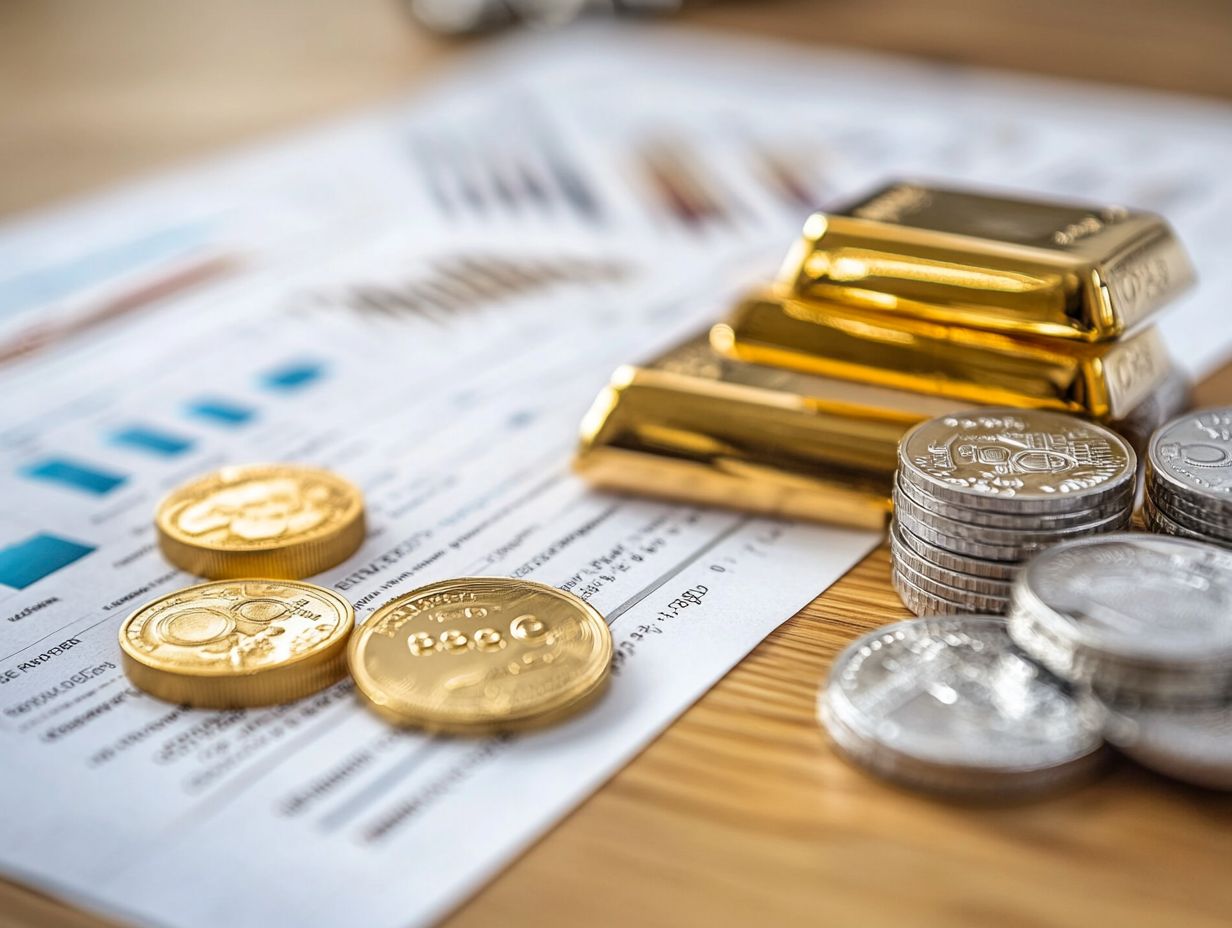
Incorporating precious metals into your investment strategy can greatly improve your diversification. This allows you to spread risk across various asset classes and create a more balanced retirement portfolio.
Imagine the potential downturns in the stock market or fluctuations in bond yields. By including assets like gold and silver, you can effectively mitigate these risks. When equities face volatility during economic downturns, precious metals often hold their value or even appreciate, acting as a safe haven for your investments.
Mixing alternative investments with traditional assets can cushion you against market ups and downs. In inflationary times, precious metals protect your purchasing power more effectively than conventional assets.
A well-rounded portfolio that includes precious metals reduces risk and fosters potential long-term growth, setting you up for a more secure financial future.
Tax Benefits
Investing in precious metals within tax-advantaged accounts offers you significant tax benefits, including tax-deferred growth and potential exemptions from the tax on the profit made from selling an asset upon qualified withdrawals.
This strategy can boost your returns, especially when the market is unstable. However, it’s essential to remain vigilant about various custodial fees and transaction costs, as these can impact your net gains.
Understanding the rules set by the IRS, the U.S. tax authority, is crucial. Adhering to specific guidelines ensures your assets are held in eligible accounts, shielding them from unnecessary taxation. Familiarity with the role of precious metals in tax-deferred accounts and annual contribution limits adds another layer to your investment strategy, empowering you to make smarter decisions that align with your long-term financial goals.
Types of Precious Metals Suitable for Tax-Advantaged Accounts
You can include a variety of precious metals in your tax-advantaged accounts, such as gold, silver, platinum, and palladium.
Each of these metals brings its own set of unique benefits, providing you with excellent options for diversification and safeguarding your wealth.
Gold, Silver, Platinum, and Palladium
Gold, silver, platinum, and palladium are not just shiny objects; they are highly esteemed precious metals that serve as tangible assets. They play a pivotal role in various investment strategies thanks to their unique properties and market demand.
Each of these metals has captivating characteristics that have intrigued investors for centuries. Gold, often viewed as a safe haven during economic turbulence, has a long history as both currency and a symbol of wealth.
Silver offers not only aesthetic allure but also a multitude of industrial applications, making it a remarkably versatile investment. Platinum is valued for its rarity and its critical function in catalytic converters, particularly as the automotive industry increasingly embraces sustainability.
Meanwhile, palladium has experienced a surge in demand driven by its role in green technologies and emissions reduction. Understanding these details sharpens your investment choices and highlights why these precious metals remain vital in today s financial landscape.
How to Invest in Precious Metals through Tax-Advantaged Accounts
When you invest in precious metals through tax-advantaged accounts such as IRAs and 401(k)s, it s crucial to cultivate a strategic understanding of custodians, IRS regulations, and the market conditions that can influence your investment decisions.
This knowledge empowers you to navigate the complexities of precious metal investments with confidence and precision.
IRA and 401(k) Options
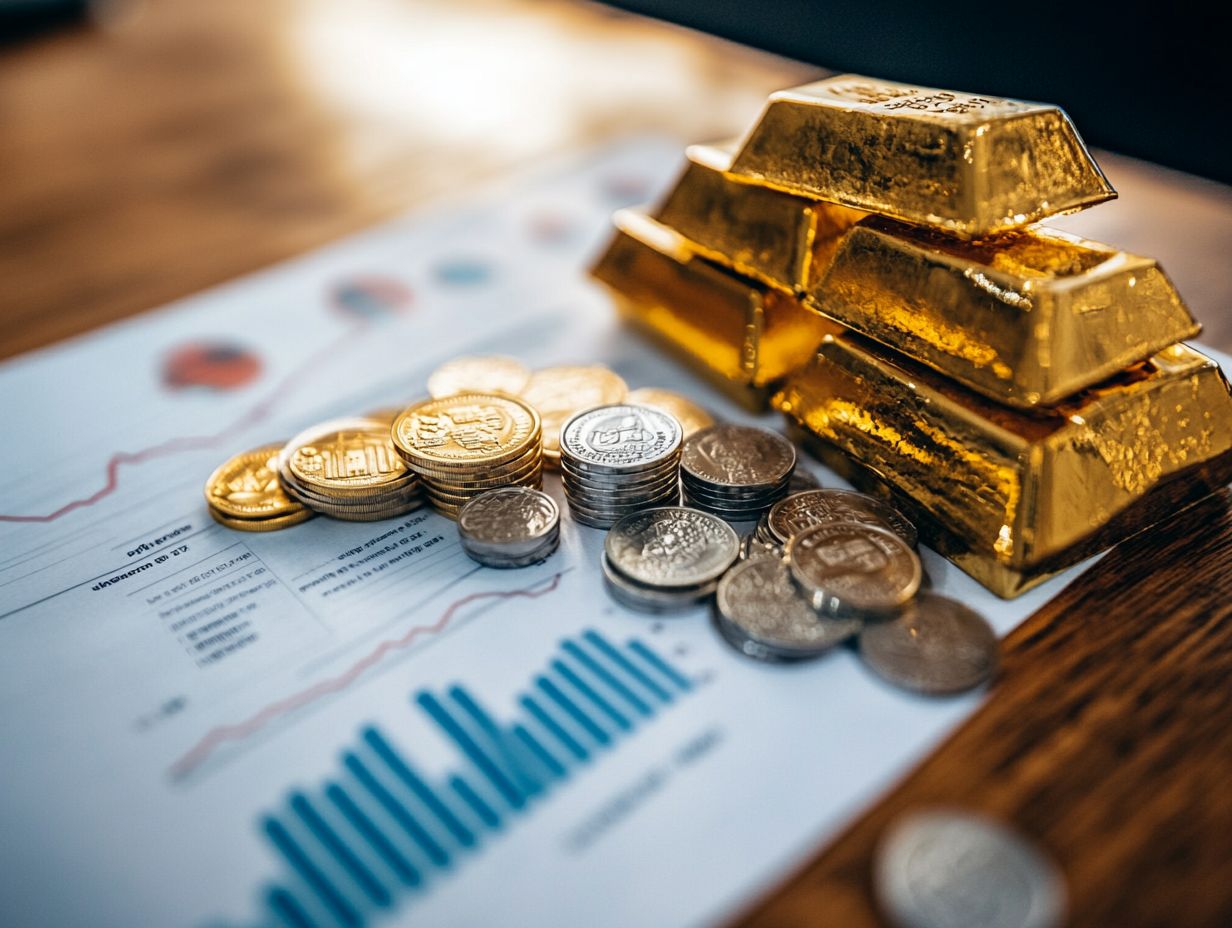
Both IRAs and 401(k) plans offer distinct tax-advantaged avenues for investing in precious metals. This enables you to diversify your retirement portfolio while enjoying the benefits of tax deferral.
In an IRA, you can typically hold a range of approved precious metals, including gold, silver, platinum, and palladium, provided they meet specific purity standards. On the other hand, 401(k) plans tend to have more restrictions regarding investment options. They often allow precious metals only within a broader self-directed plan that lets you choose your investments. It’s also important to consider the tax impact of importing precious metals when making these investments.
While your individual contributions to IRAs are capped at a certain limit each year, 401(k) plans often allow higher contributions, especially if your employer offers matching funds.
The responsibilities of custodians vary significantly. IRAs require a dedicated custodian to manage your assets, while 401(k) plans are generally administered by your employer or a selected financial institution, which can affect how much control you have over your investment decisions.
Key IRS Rules for Precious Metals
Adhering to IRS regulations is essential when you invest in precious metals within tax-advantaged accounts. This compliance not only safeguards the integrity of your retirement funds but also helps minimize custodial fees.
As you navigate this intricate landscape, it s crucial to understand now that only specific metals such as gold, silver, platinum, and palladium are allowed in these accounts. Each of these metals must meet precise purity standards established by the IRS to qualify.
Partnering with IRS-approved custodians is vital, as they facilitate transactions within Individual Retirement Accounts and 401(k)s, helping you avoid any potential missteps.
Neglecting these guidelines can lead to severe penalties, including disqualification of your account and tax liabilities that could significantly erode your retirement savings.
Considerations and Risks
When you invest in precious metals through tax-advantaged accounts, it s crucial to weigh the various risks tied to market volatility and liquidity. These factors can profoundly influence your investment returns and shape the effectiveness of your overall retirement savings strategy.
Market Volatility and Liquidity
Market volatility can significantly impact the liquidity of precious metals. Understanding how these fluctuations influence investment risk and overall portfolio performance is essential.
When market conditions shift dramatically, the ease with which you can buy or sell precious metals often changes as well. For instance, during economic uncertainty, you might notice that both gold and silver prices tend to rise due to increased demand. However, actual transactions can slow down as traders exercise heightened caution.
This unpredictability means you may need to adjust your investment strategy. Those who adapt to evolving liquidity conditions can effectively capitalize on pricing opportunities.
Ultimately, having a keen awareness of the interplay between volatility and market depth not only shapes your investment decisions but also influences how you approach risk management.
Storage and Custody Fees
When you invest in precious metals, grasping the intricacies of storage and custodial fees becomes essential. These can significantly affect the overall cost and returns of your investment, especially within tax-advantaged accounts.
Many investors overlook the subtleties of secure storage options, which can profoundly influence financial outcomes. While secure facilities provide peace of mind, they often come with custodial fees that vary widely based on the level of security and service offered.
Common charges may include:
- Annual maintenance fees
- Insurance costs
- Transaction fees for buying or selling
These expenses can add up over time. Being aware of these costs is crucial, as they can chip away at the potential profits from your precious metals, particularly if you re considering a long-term strategy.
Thus, conducting thorough research into custodial services is vital for optimizing your investment returns.
Frequently Asked Questions
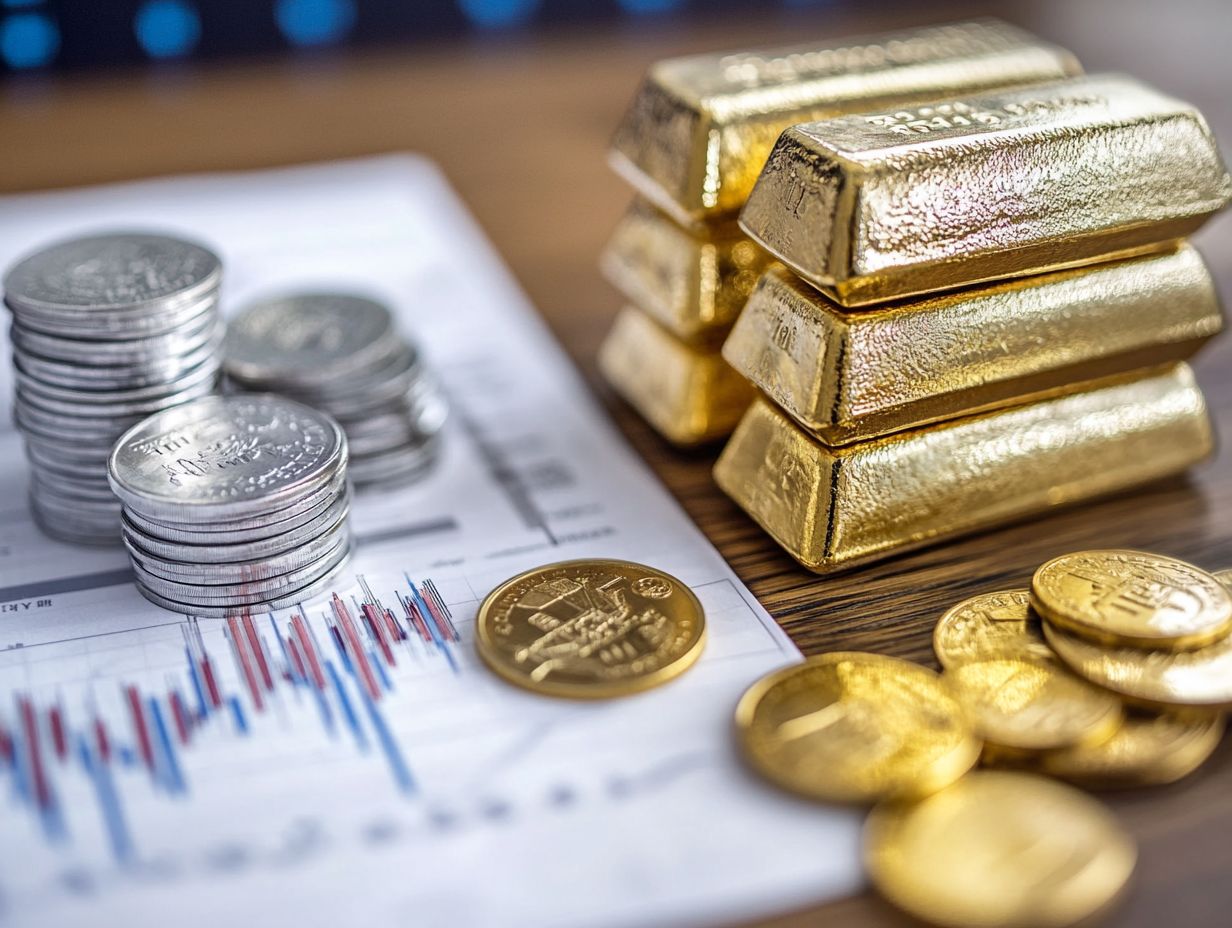
What are tax-advantaged accounts?
Tax-advantaged accounts are investment accounts that provide tax benefits. They are designed to promote saving for retirement and other long-term goals.
What are precious metals?
Precious metals are rare and valuable materials like gold, silver, platinum, and palladium. They have served as currency and means of trade for centuries.
Why should I consider investing in precious metals within a tax-advantaged account?
Investing in precious metals within a tax-advantaged account offers tax benefits. You can enjoy tax-deferred growth or tax-free withdrawals, boosting your investment’s value.
What are the different types of tax-advantaged accounts that allow investment in precious metals?
Several tax-advantaged accounts permit precious metal investments. Individual Retirement Accounts (IRAs), 401(k) plans, Health Savings Accounts (HSAs), and Education Savings Accounts (ESAs) are key examples.
Are there restrictions on the types of precious metals that can be held in a tax-advantaged account?
Yes, the IRS sets rules for what precious metals can be held in these accounts. Typically, only bullion and coins that meet specific purity and content standards are allowed.
What are the potential risks and benefits of investing in precious metals within a tax-advantaged account?
Investing in precious metals carries risks, such as price fluctuations. You may also face restrictions on accessing funds until retirement.
On the flip side, you gain potential tax advantages and diversify your investment portfolio.











